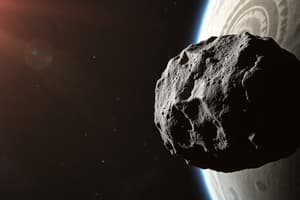Podcast
Questions and Answers
Earth’s second moon is known as asteroid ______.
Earth’s second moon is known as asteroid ______.
2024 PT5
The tiny asteroid measures just ______ feet wide.
The tiny asteroid measures just ______ feet wide.
37
The capture of 2024 PT5 began on September 29, ______.
The capture of 2024 PT5 began on September 29, ______.
2024
Earth's primary moon has a diameter of ______ miles.
Earth's primary moon has a diameter of ______ miles.
Asteroid 2024 PT5 is part of the ______ asteroid belt.
Asteroid 2024 PT5 is part of the ______ asteroid belt.
Asteroid 2024 PT5 is expected to leave Earth's orbit on November 25, ______.
Asteroid 2024 PT5 is expected to leave Earth's orbit on November 25, ______.
Richard Binzel is an astronomer at the Massachusetts Institute of ______.
Richard Binzel is an astronomer at the Massachusetts Institute of ______.
Carlos de la Fuente Marcos likens 2024 PT5 to a ______ shopper.
Carlos de la Fuente Marcos likens 2024 PT5 to a ______ shopper.
Mini-moons like 2024 PT5 serve as natural cosmic ______.
Mini-moons like 2024 PT5 serve as natural cosmic ______.
The study of mini-moons contributes to our understanding of near-Earth ______.
The study of mini-moons contributes to our understanding of near-Earth ______.
Researchers hope to gather ______ or test new spacecraft designs using mini-moons.
Researchers hope to gather ______ or test new spacecraft designs using mini-moons.
Mini-moons highlight the ever-changing nature of our cosmic ______.
Mini-moons highlight the ever-changing nature of our cosmic ______.
Earth’s second moon may be temporary, but it presents new avenues for ______.
Earth’s second moon may be temporary, but it presents new avenues for ______.
As technology advances, researchers aim to study these fleeting ______ more closely.
As technology advances, researchers aim to study these fleeting ______ more closely.
These temporary captures act as natural cosmic laboratories, providing insights into the composition of ______.
These temporary captures act as natural cosmic laboratories, providing insights into the composition of ______.
Flashcards
Earth's second moon
Earth's second moon
Asteroid 2024 PT5, which was temporarily captured by Earth's gravity in September 2024.
Asteroid 2024 PT5
Asteroid 2024 PT5
A small asteroid orbiting Earth for a brief period, known as Earth's second moon.
Arjuna asteroid belt
Arjuna asteroid belt
A group of asteroids that follow orbits similar to Earth's, about 93 million miles from the Sun.
Temporary satellite
Temporary satellite
Signup and view all the flashcards
Size difference
Size difference
Signup and view all the flashcards
Gravitational pull
Gravitational pull
Signup and view all the flashcards
Celestial companion
Celestial companion
Signup and view all the flashcards
Capture Time
Capture Time
Signup and view all the flashcards
Mini-moons
Mini-moons
Signup and view all the flashcards
Scientific study of mini-moons
Scientific study of mini-moons
Signup and view all the flashcards
2024 PT5
2024 PT5
Signup and view all the flashcards
Natural cosmic laboratories
Natural cosmic laboratories
Signup and view all the flashcards
Near-Earth asteroids
Near-Earth asteroids
Signup and view all the flashcards
Future space missions
Future space missions
Signup and view all the flashcards
Dynamic solar system
Dynamic solar system
Signup and view all the flashcards
Study Notes
Earth's Second Moon
- Asteroid 2024 PT5, a 37-foot wide asteroid, became a temporary moon of Earth on September 29, 2024.
- It was captured by Earth's gravity and will leave orbit on November 25, 2024.
- Astronomers at Complutense University of Madrid discovered it.
Characteristics of 2024 PT5
- Significantly smaller than Earth's primary moon (2,159 miles wide); approximately 300,000 times smaller.
- Originated from the Arjuna asteroid belt, around 93 million miles from the sun.
- Travelled at less than 2,200 miles per hour.
- Approached Earth at a close range of 2.8 million miles.
Orbital Behavior of Mini-Moons
- Asteroid 2024 PT5 is a "window shopper" rather than a true moon; it does not complete a full orbit.
- The duration of its stay is relatively brief.
- Capture began at 3:54 p.m. EDT on September 29, 2024, and is expected to end at 11:43 a.m. EDT on November 25, 2024.
Scientific Significance
- Mini-moons like 2024 PT5 are valuable for studying near-Earth objects (NEOs).
- They provide a unique opportunity to analyze the composition of asteroids and solar system dynamics.
- Studying these temporary satellites helps improve models of asteroid behavior.
- Allows better prediction and mitigation of potential collisions with Earth.
Future Implications
- Advancements in technology may allow for closer study of these fleeting visitors.
- Future missions could attempt sample collection or use them for spacecraft testing.
- The discovery underscores the dynamism of our solar system and the ongoing need for exploration.
Studying That Suits You
Use AI to generate personalized quizzes and flashcards to suit your learning preferences.




